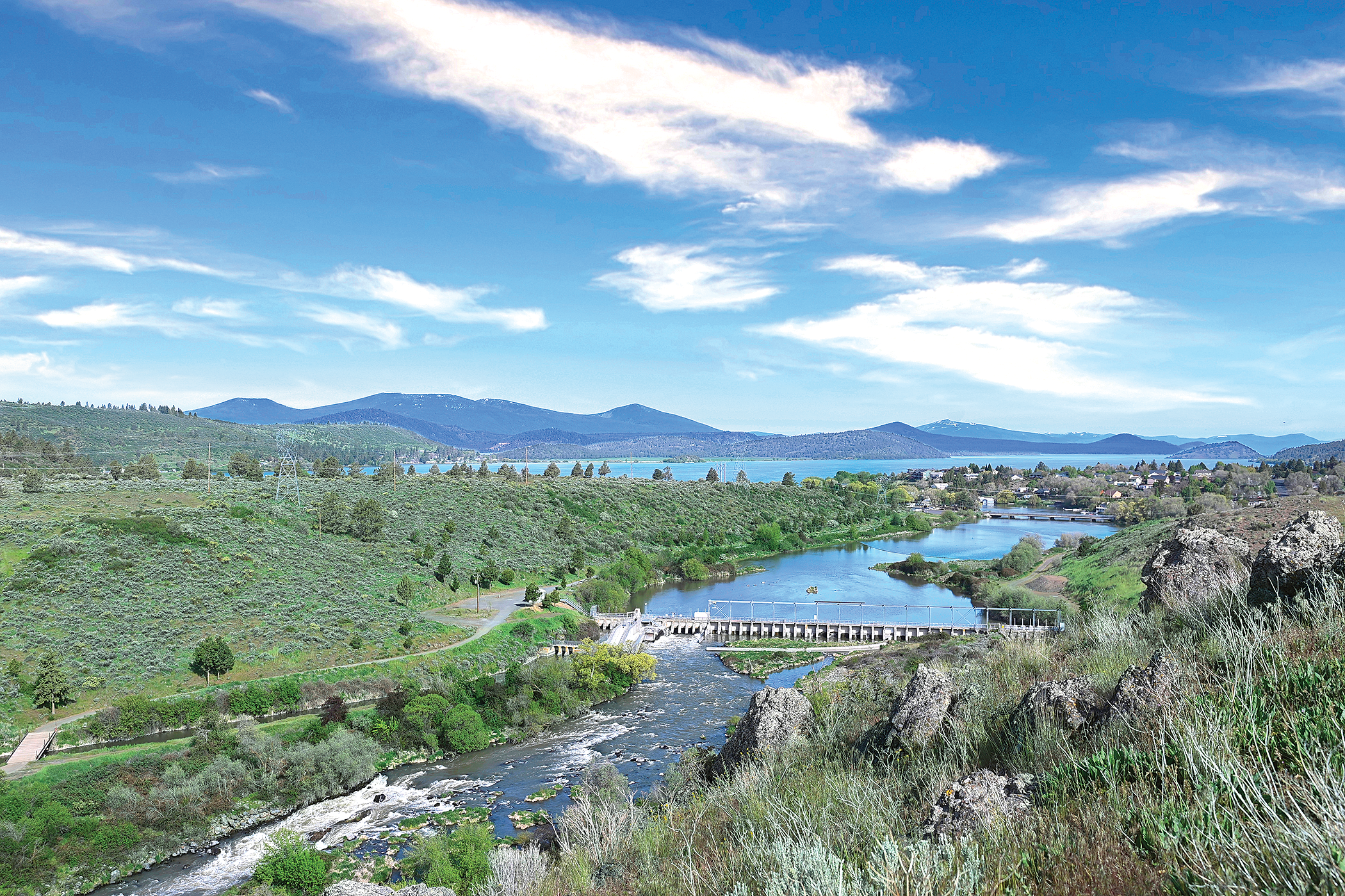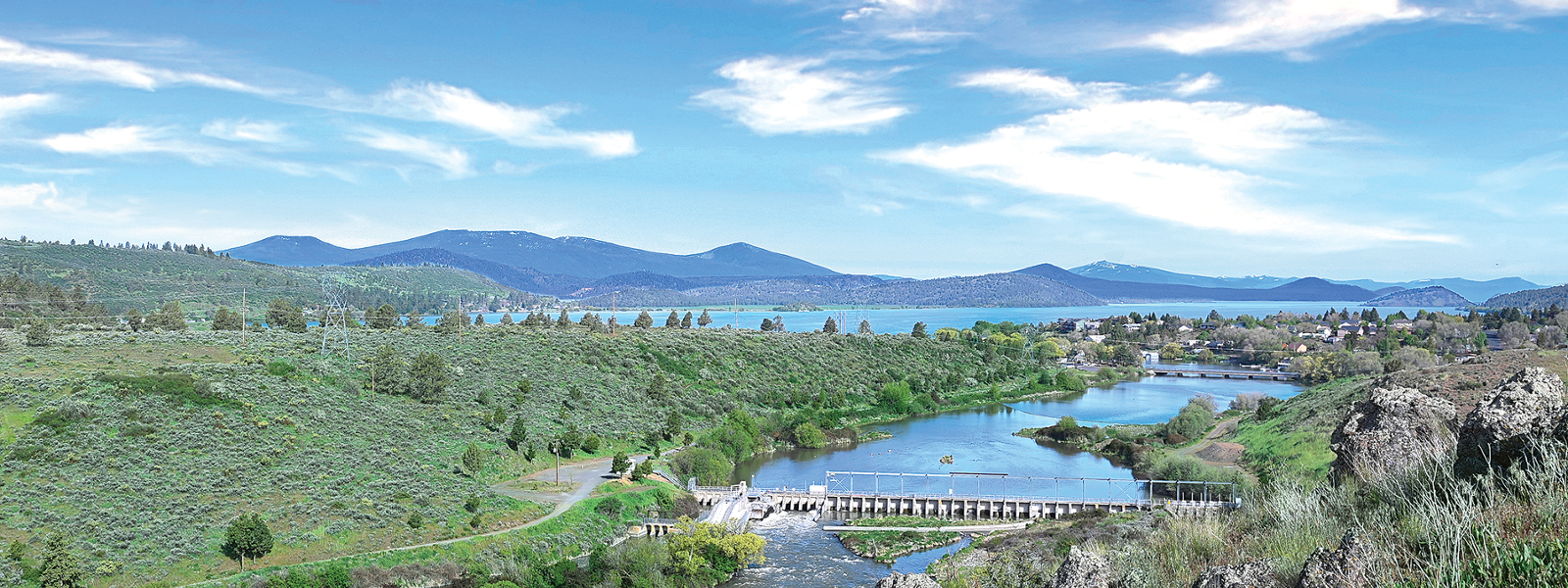Klamath farmers hope to harvest crops before shutoff

A view of Link River Dam west of Klamath Falls, Oregon, in May. The dam regulates water in Upper Klamath Lake, the principal source of water for the federal Klamath Water Project.
Photo/Chelsea Shearer

By Christine Souza
Even with a more positive water outlook in early 2023, irrigators of the federal Klamath Water Project who are nearing the end of the growing season say they hope to finish harvest before their water supply is cut off in the coming weeks.
Siskiyou County farmer Scott Seus of Tulelake-based Seus Farms, which grows a variety of crops including horseradish, onions, mint and grain, said the region’s farmers face water challenges again this season, despite a plentiful water year.
“It’s hard to fathom. They tell you there’s not enough water to go around, yet you have 220% of normal precipitation and you should be closer to 300,000 acre-feet or 280,000 (acre-feet) reasonably,” Seus said, referring to the U.S. Bureau of Reclamation that manages the Klamath Water Project, which relies on water from Upper Klamath Lake and the Klamath River. “There’s a strong probability that they are going to shut our water off before the end of the season.
“With irrigated row crops,” he added, “we need to get to the other side of Sept. 15. It is pretty reasonable right now to think that we’re not going to get there.”
For the Klamath Water Project, water from Upper Klamath Lake is dedicated to fish species based on regulatory guidelines put in place by the National Marine Fisheries Service and U.S. Fish and Wildlife Service.
NMFS has authority related to coho salmon, and USFWS has authority related to Lost River suckers and shortnose suckers. To manage for the needs of fish, federal agencies extended the interim operations plan to Oct. 31, 2024, after it expired in September 2022.
Based on the operations plan and the water supply from Upper Klamath Lake, Klamath Water Users Association Executive Director and Counsel Paul Simmons said project irrigators should have received 285,000 acre-feet in 2023. However, this spring, the bureau announced an initial supply of 215,000 acre-feet.
Influencing the water-supply allocation was a request by the Yurok Tribe and other plaintiffs this spring asking the federal court in San Francisco to order a lake elevation of 4,139.2 feet. The court denied the plaintiffs’ motion on May 10, Simmons said, yet the bureau responded days later calling for what the plaintiffs asked for—a minimum lake level of 4,139.2 feet.
Simmons called the lake level “an arbitrary number from the clear blue sky,” adding that the biological opinion for endangered suckers calls for a minimum lake level of 4,138 feet, a difference equating to 80,000 acre-feet. Annual average demand by the project is between 320,000 acre-feet and 400,000 acre-feet, he said.
Farmers were counting on more water supplies this year after they suffered from severe cutbacks in water deliveries during recent extreme drought years. In 2022, the bureau granted an initial allocation of 50,000 acre-feet. In 2021, the initial allocation was 33,000 acre-feet.
To accommodate for the lower-than-hoped-for water allocation this year, Seus said growers had to cut back on planted acres.
“Nobody gets through this if everybody plants 100%, so we set some acres aside. We used well water early, and we’re probably going to have to finish with some well water,” said Seus, who is on the board of the Tulelake Irrigation District.
“We believe that we’re going to be out of water in the very near future,” he added. “That allocation will get used up, and we’ll be back on wells to finish things.”
As growers plan water budgets to carry them through the end of the season, Seus said crops are in good shape. He said some grain was grown using deficit irrigation, and row crops such as horseradish, onions and mint look good.
“It is nice to drive around and see as many green fields as there are, but our concern is whether or not we can finish them,” Seus said.
Fellow Tulelake farmer Marc Staunton of Staunton Farms, which farms row crops and is a member of Cal-Ore Produce, a grower-packer-shipper of fresh potatoes, said he is concerned about finishing the season because much has been invested in planting and growing the crops.
“We’ve pretty much made all investments at this point except for the cost of harvest,” said Staunton, president of Cal-Ore Produce and a TID board member. “Basically, we’ve almost fully spent our budget on growing the crop, so all we have to do is finish with water, and if it gets cut short, then we would be missing any opportunity of profit.”
This far into the growing season, Staunton said he and other growers have spent most of the budget on planting costs, including for seed and preplant fertilizer, and growing costs such as for fertigation, chemigation, labor and other inputs.
“All you’ve got to do is finish the crop with water and harvest to get paid, so it’s definitely concerning to get this far into the crop and be concerned about a shutoff,” said Staunton, who farms potatoes, onions, garlic, alfalfa and cereal grains.
In terms of balancing water among the various users in the basin, Staunton suggested there must be a better way.
“Why can’t we work together and talk this out instead of ending up in a courtroom?” Staunton said. “If people could stop trying to manage water in the courtroom, you could have conversations about individual needs like tribal needs and tribal concerns, and also farmers’ needs and farmers’ concerns and come up with a solution.”
Speaking of a basin-wide solution, Simmons said, “We need some sort of negotiated agreement. Otherwise, this conflict will go on forever. In the last three years, I think there’s been at least one lawsuit every year.”
(Christine Souza is an assistant editor of Ag Alert. She may be contacted at csouza@cfbf.com.)




